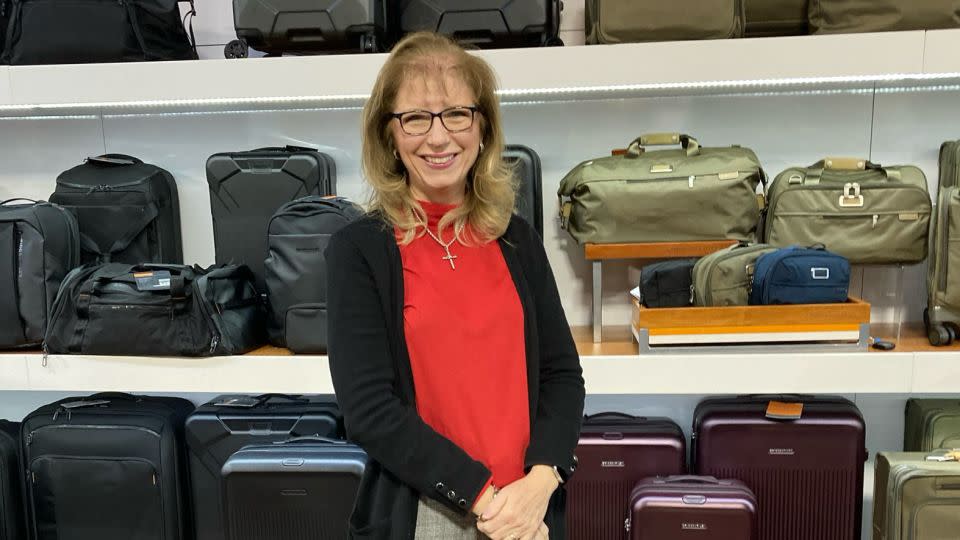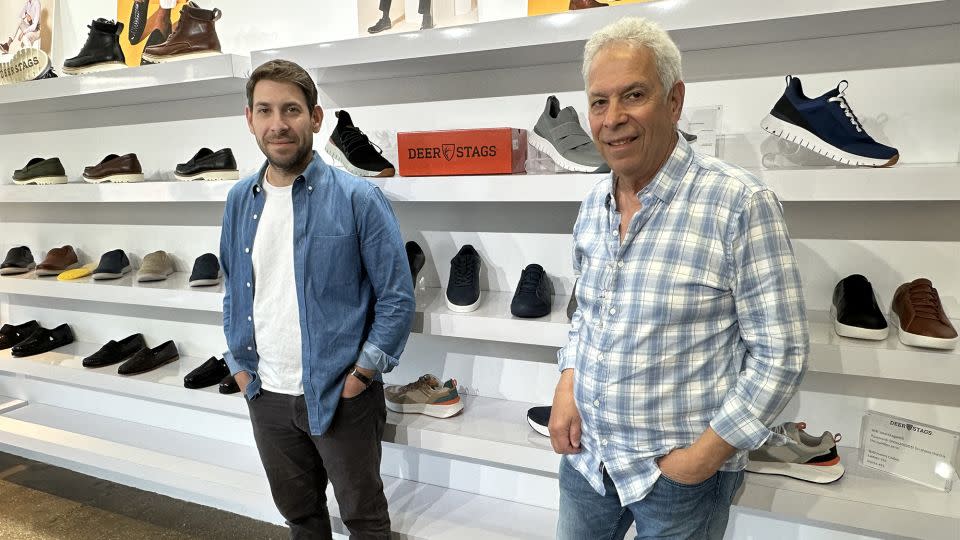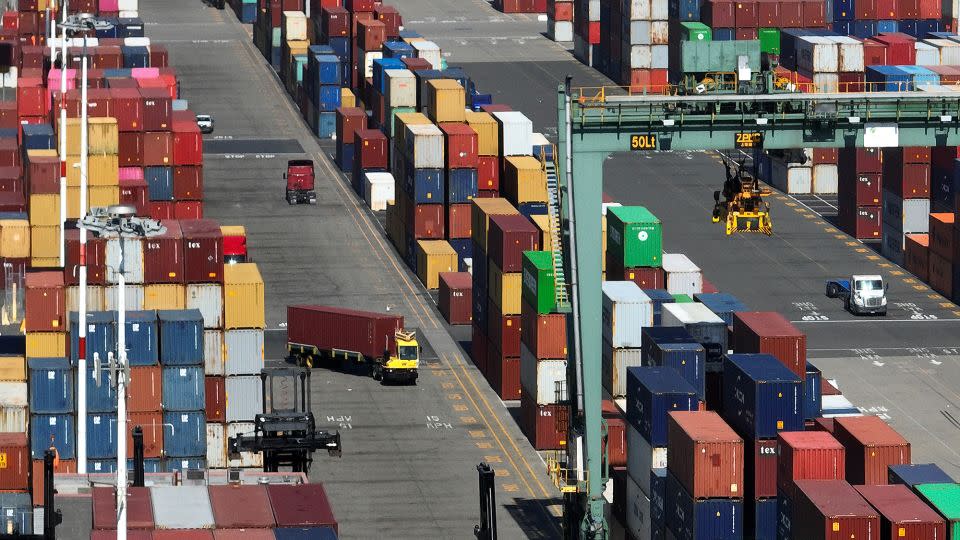Americans are still paying more for shoes, luggage and hats after Biden left Trump’s tariffs in place
In 2018, then-President Donald Trump put new tariffs on a variety of Chinese-made goods, including baseball caps, luggage and shoes – and Americans have been paying the price ever since.
For example, a suitcase that was $100 before Trump imposed the tariffs now goes for about $160, and a carry-on that was $425 is now $700, said Tiffany Zarfas Williams, who owns the Luggage Shop of Lubbock in Texas.
As a small, independent retailer, she had no choice but to raise prices on consumers to keep up with what she was charged by the brand name distributors, which paid the tariffs on the imported goods.
“It’s a real challenge having to pass those kinds of price increases to the consumer,” she said.
Tariffs aren’t the only reason prices went up over the last five years, but Zarfas Williams said she hoped President Joe Biden would lift the duties – which he previously criticized – to help alleviate some of the upward pressure on prices.
“Trump doesn’t get the basics,” Biden said in a post on X in June 2019. “He thinks tariffs are being paid by China. Any freshman econ student could tell you that the American people are paying his tariffs.”
But after a multi-year review of the duties was released last month, the Biden administration decided to keep them in place and raise the rate on a relatively small share of the impacted imports, including things like electrical vehicles and semiconductors made in China.
Inflation, which soared earlier during the Biden administration, has cooled even with the tariffs still in place. But Biden’s handling of the economy has dogged his approval ratings. Consumers’ continued anxiety over high prices could be a political liability as he campaigns for reelection against Trump in November.
While both candidates have embraced tariffs to protect US industries from China’s unfair trade practices, Biden’s strategy has hit far fewer goods than Trump’s latest proposal to impose a tariff of at least 10% on all $3 trillion worth of US imports if he wins a second term.

The tariffs Biden left in place – which are paid by US importers and not China – hit roughly $300 billion of goods. And he’s planning to raise the rate on about $18 billion of those goods over the next two years.
Supply chain problems that built up after the Covid-19 pandemic and the Russian invasion of Ukraine are also to blame for fueling inflation. But footwear and apparel trade groups say the tariffs on Chinese goods have certainly contributed to rising prices.
How tariffs drive up consumer costs
When Chinese-made shoes arrive at a US port, American importers like family-run shoe seller Deer Stags pay the tariff.
Known for selling comfortable footwear to retailers like JCPenney, Kohl’s and Macy’s, Deer Stags has been importing most of its shoe line from China since the 1980s, said the company’s president, Rick Muskat.
Even though he’d like to get a US supplier, a variety of factors – including earlier tariffs – helped shift most US shoe manufacturing offshore. In 2019, Trump’s new tariffs added a 15% duty on about half of the footwear imports from China. He later lowered the rate to 7.5% in 2020, where it remains.

Since the additional tariffs made the shoes more expensive for Deer Stags, Muskat had two choices: either eat the cost of the tariff, impacting his business’s bottom line, or pass some of it along to the consumer.
He decided to do a little bit of both.
It was harder to get customers to pay more for existing styles that Deer Stags had carried for a long time, he said. So the company ended up eating the cost of the tariffs placed on some older styles and charging more for some new items.
“I developed a new style that never existed in our line before that’s subject to the tariffs. So when we do our calculations and try to maintain our margins, those shoes ended up costing more than they would have had the tariff not been implemented,” Muskat said.
After Trump’s tariffs hit, some US companies sought new manufacturers in other countries. As a result, China’s share of total US footwear imports fell from 53% in 2018 to 40% in 2022, according to a report produced for apparel and footwear trade groups.
But Muskat hasn’t changed suppliers because he found moving production wasn’t going to be cost effective.
The Chinese are “very efficient at what they do. They can make a better product at a lower price, and the American consumer appreciates that,” Muskat said.
Phil Page, chairman of Missouri-based Cap America, also raised prices because of the tariffs. The company embroiders caps to sell to distributors of promotional products.
Before the trade war began under Trump, Cap America imported most of its inventory directly from China. But once the tariffs hit, Page said, some Chinese manufacturers scrambled to move to other countries to avoid the US tariffs.

Now, some of his imported caps are made in Vietnam and Bangladesh – but they aren’t any cheaper than importing from China. Page said he’s paying about the same, but the manufacturer is getting more money rather than the US government, which collects the tariff revenue.
“Really all the tariffs did was scatter the flock around and cost American consumers billions of dollars,” Page said.
Are tariffs to blame for inflation?
Economists generally agree that tariffs drive up prices. JP Morgan economists estimated in 2019 that Trump’s tariffs on about $300 billion of Chinese-made goods would cost the average American household $1,000 a year.
But it’s hard to determine just how much the tariffs – which didn’t occur in a vacuum – ultimately contributed to the high inflation the US economy has experienced in recent years. More recently, housing prices are largely to blame for keeping inflation high.
The Covid-19 pandemic upended the global economy roughly two years after Trump’s trade war began.
Several studies show that Trump’s tariffs only marginally contributed to the rise in US inflation experienced after the pandemic and the following supply chain crisis.
But when it comes to apparel, footwear and travel goods, industry trade groups say that the tariffs have undeniably helped to drive up prices on American consumers.
The tariffs “definitely contributed to the inflation we’ve seen over the last few years. Obviously there are other factors there, like the supply chain price. But we were a deflationary industry that turned when the China tariffs went into effect,” said Nate Herman, senior vice president of policy at the American Apparel & Footwear Association.
Until recently, average prices on apparel had been trending downward since the 1990s, according to data from the Bureau of Labor Statistics.
There’s an “unmistakable correlation” between the tariffs and how much Americans are paying for shoes, said Matt Priest, president and CEO of the Footwear Distributors and Retailers of America.
If Biden had lifted the tariffs, Priest believes shoe prices would eventually come down due to the highly competitive nature of the industry. Hypothetically, one company would inevitably lower their prices and then others would do the same to compete.
In a letter sent to Biden in May, major shoe brands, including Adidas, Columbia Sportswear, Nike and Steve Madden, urged the administration to lift the tariffs.
“We are confident that removing 301 tariffs will alleviate a costly burden in this key area and translate to savings for our shoppers,” they wrote, referring to the section of the law Trump used to impose the tariffs.
Biden announced he was keeping the duties in place four days after the letter was sent.
The Biden administration has said the tariffs are one part of its overall strategy to strengthen US supply chains and protect American consumers and workers from China’s unfair trading practices. China is known for subsidizing its own manufacturers, who then flood the global market with cheaper goods.
“Those tariffs have been in place in order to help, I think, balance out some of those dynamics that have been in place for a while,” Jared Bernstein, chair of the White House Council of Economic Advisers, said Wednesday when asked about why the tariffs were left in place.
He noted how US inflation has come down to 3.3%. It had soared earlier during Biden’s term, peaking in June 2022 at 9.1%.
“I think the important thing to recognize is that while those tariffs were in place, we had strong GDP growth, certainly avoided a recession that many people said was almost inevitable, we’ve had unemployment below 4% for over two-and-a-half years,” Bernstein said.
Protecting US businesses from China
Business leaders across the US, as well as lawmakers on both sides of the aisle, tend to agree that China’s unfair trade policies, such as intellectual property theft and forced technology transfers, need to be addressed. Trump’s tariffs were meant to get China to address those issues.
But the US Trade Representative’s office recently said that while the tariffs have been “effective in encouraging” China to “take steps” toward ending some of its unfair trade practices, it “has not eliminated many of its technology transfer-related acts, policies, and practices.”
The textile industry, for example, is in favor of not only keeping the tariffs, but raising them. The National Council of Textile Organizations has pressed the Biden administration to increase the rate of the duties on textiles and apparel in order to protect domestic manufacturing from what it calls the “flood of under-valued, subsidized and illegal imports from China.”

But leaders of the apparel and footwear industries say they didn’t ask for the tariff protections.
“There are issues with China in terms of intellectual property and a lot of counterfeit product comes out of China, but the tariff policy has done nothing – and we don’t think will do anything – to address that issue,” Herman said.
While Trump did get Chinese President Xi Jinping to the negotiating table, some of the commitments China made in an agreement reached in January 2020 never came to fruition.
Under what’s known as the Phase One agreement, China agreed to increase its purchases of US goods and agricultural products – setting a target of buying $200 billion more than it did before the trade war began. But China fell well short of that pledge.
A Phase Two agreement was never reached between the US and China under either the Trump or Biden administrations.
Biden “had a great opportunity to set a new policy and set a new direction, and all he’s done is outsource his tariff policy to former President Trump,” Herman said.
For more CNN news and newsletters create an account at CNN.com

 Yahoo Finance
Yahoo Finance 